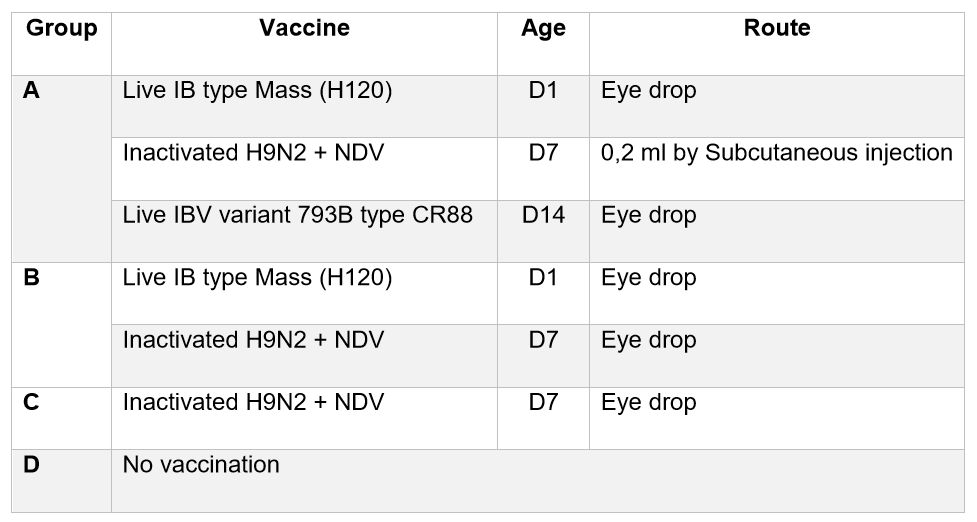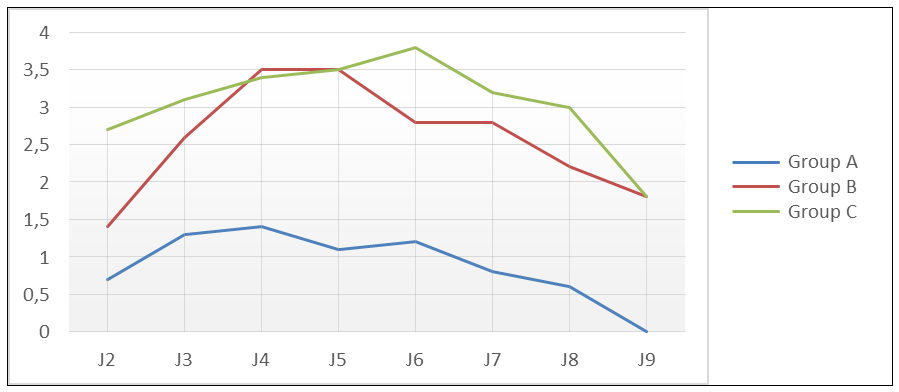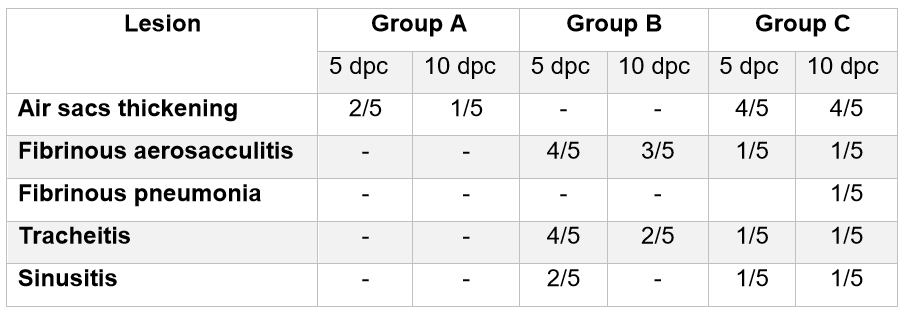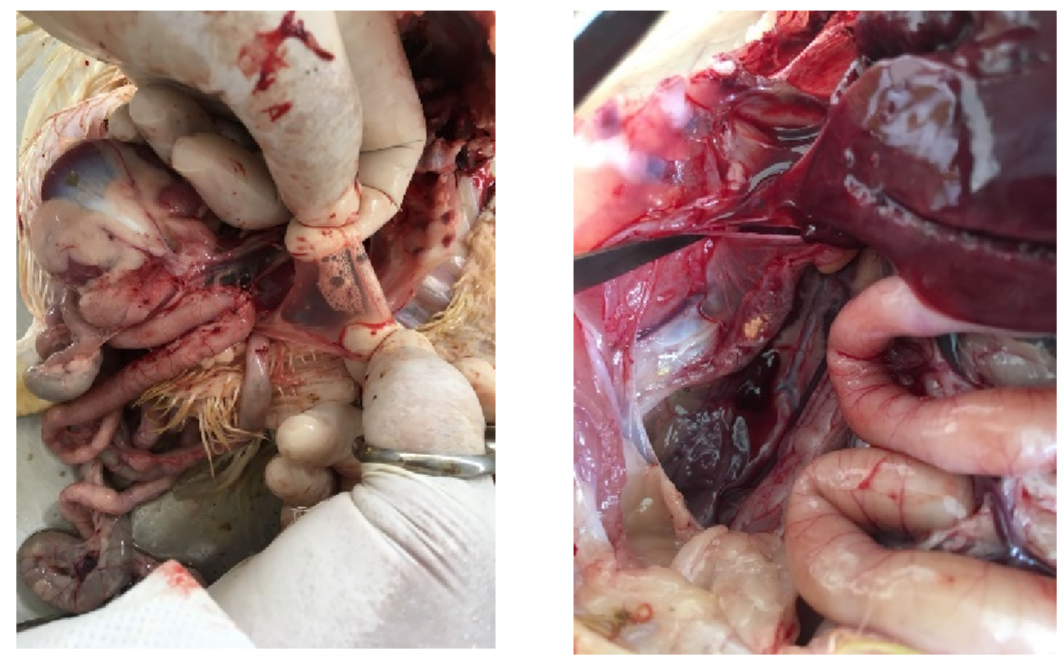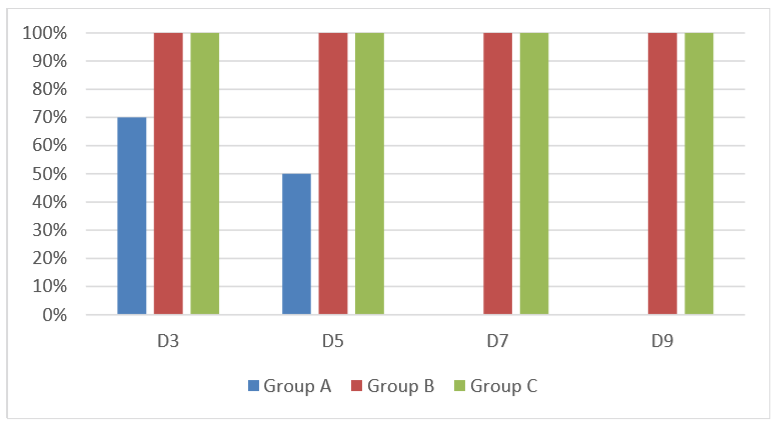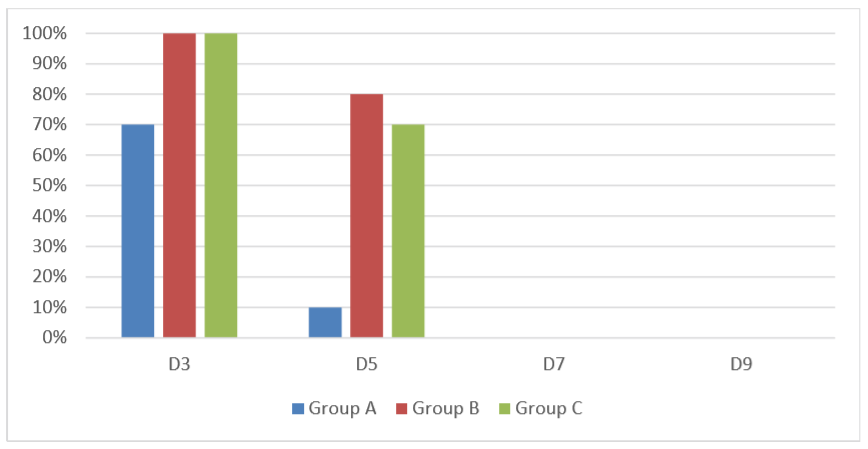



Study shows vaccination programmes containing both AI and IB vaccines are most effective to prevent respiratory diseases
The protection conferred by vaccination programs using IBV mass type H120, IBV variant 793B type CR88 and inactivated AIV H9N2 vaccines against a combined virulent challenge with Moroccan isolates of AIV H9N2 and infectious bronchitis virus.by T. RAWI 1; S. LEMIERE 2; M. ELHOUADFI 3, S. FELLAHI 3 1 MCI Santé Animale, Mohammedia, Morocco; 2 Boehringer Ingelheim Animal Health, 29 avenue Tony Garnier, 69348 Lyon, France: 3 Institut Agronomique et Vétérinaire Hassan II, Rabat, Morocco.
Abstract:
Since the first reports of AIV H9N2 in Morocco, controlling respiratory diseases became more difficult, mainly because of co-infections of birds with avian influenza virus H9N2 (AIV H9N2) and classical and variant infectious bronchitis viruses (IBV).
The objective of this study was to estimate the protection conferred by 3 different vaccination programs based on inactivated bivalent ND + AIV H9N2 vaccine, IBV mass type H120 and IBV variant 793B type CR88 live vaccines against a combined challenge with virulent Moroccan isolates of AIV H9N2 and IBV variant IT02.
We assessed the efficacy of these vaccination programs by a 10-day follow-up postchallenge for respiratory signs, mortality and tracheal excretion of both challenge viruses by qRT-PCR.
The results show clearly the importance of using a complete IB program as the group that receives the IBV mass type H120 + IBV variant 793B type CR88 live + Inactivated H9N2 showed less clinical signs and excreted less IB and H9N2 viruses.
Introduction:
Moroccan poultry industry experienced in 2016 its first H9N2 outbreaks with a huge impact on health and productivity of all avian production types (El Houadfi et al, 2016). To face the new disease, farmers raised the biosecurity level of their units and vaccination was implemented.
The situation stabilised in breeders, layers and turkeys while the management of respiratory diseases in broilers became very difficult and the losses did continue. The reasons behind this situation is the poor quality of biosecurity barriers in broilers farms and the incomplete vaccination programs especially regarding variant IBV even though we have clear evidence of the circulation of several types of IBV variants in Morocco that are related to 793/B and IT02 families (Fellahi et al, 2015).
The aim of our study was to demonstrate the impact of the use of an IB vaccination program that combines IBV mass type H120 + IBV variant 793B type CR88 live with an inactivated H9N2 vaccine in comparison with a program using only IBV mass type H120 with inactivated H9N2 (the most used in Morocco by farmers).
Material & Methods:
80 commercial day old chicks were separated into 4 groups: 3 vaccinated groups (A,B & C) with different vaccination programs and one unvaccinated group (D).
Vaccination programs are presented in the table below:
At 28 day of age, the challenged birds received a mix of 0.2 ml of Moroccan AIV H9N2 at 107 EID 50/ml and Moroccan IBV variant isolate linked to IT02 at 103 EID 50/ml via oculo-nasal route; the two viruses are 2017 field isolates.
All birds were observed daily during 10 days post challenge for clinical symptoms, respiratory rales according to this scoring model: 0= No symptoms, 1=Dyspnea without rales, 2= Presence of respiratory rales, 3= Severe Rales, 4= Severe rales with other clinical signs attributable to H9N2 or/and IB infection. Five (5) birds from groups A, B & C were humanely euthanized at 5 and 10 days post-challenge; Gross lesions were evaluated. Oral swabs at 3, 5, 7 and 9 days post- challenge (dpc) were collected and stored at 20°C for viral RNA detection using real time reverse transcription– polymerase chain reaction (qRT-PCR) for Avian Influenza H9N2 (AIV H9N2) and Infectious Bronchitis virus (IBV). Clinical signs, presence of lesions and virus excretion assessed the protection.
Results:
- Clinical signs
Group A showed, during the 10 days follow-up post-challenge, mild respiratory symptoms without rales, mainly between D3 and D7 while both B & C groups showed severe clinical signs, severe rales, and intense respiratory distress between D2 and D8. Group D birds did not show any clinical sign during this period.
Figure 1: Average score of respiratory rales scores A, B & C groups
- Gross lesions:
Group A birds didn’t show any severe lesions at 5 and 10 dpc, the only lesions observed is the thickening of the air sacs while group B & C expressed lesions with higher severity including fibrinous aerosacculitis, pneumonia, tracheitis & sinusitis. No detectable gross lesions were witnessed in group D.
Table 1: Gross lesions in A, B & C groups at D5 and D10 post-challenge
- IBV tracheal excretion:
Group A excreted IBV at a lower level and for a shorter period than group B and C. In fact, at 3 dpc, 70% of group A birds excreted the virus while it reached 100% for both B and C groups. At 5 dpc, it decreased to 50% for A group and excretion stopped on day 7 whereas 100% of B & C groups birds excreted until day 9. No IBV was detected in group D.
Figure 2: IBV shedding rate for A, B & C groups at 3,5,7 & 9 dpc
- AIV H9N2 tracheal excretion:
The viral shedding rate, as determined by real time RT-PCR, was 100% in the B & C groups at 3 dpc in tracheal swabs, it decreased to 80% for group B and 70% for group C at 5 dpc. In A group, the shedding reached 70 % at 3 dpc and only 10% at 5 dpc, the proportion of positive samples in the A group was significantly lower than group B & C birds. No viral RNA was detected in the control group.
Figure 3: AIV H9N2 shedding rate for A, B & C groups at 3, 5, 7 & 9 dpc
Discussion:
Birds that received a vaccination program based on live IB type Mass (H120) + live IBV variant 793B type CR88 and an inactivated H9N2 vaccine (Group A) had a better ability to face the combined challenge with AIV H9N2 + Moroccan IT02 when compared to birds that received live IB type Mass (H120) and inactivated H9N2 vaccine (Group B) or inactivated H9N2 vaccine no IB vaccination (Group C). The challenge induced in these birds much lower intensity clinical signs and less severe lesions. This ascertainment is related to the viral clearance as they could eliminate both IB and H9N2 challenge viruses faster than the other groups.
In this experiment, the live IB type Mass (H120) + live IBV variant 793B type CR88 program was not only able to protect against a challenge with an IT02 strain as demonstrated in previous studies (Massi et al, 2009; Ganapathy et al, 2009). It also gives the birds the ability to better profit from the H9N2 inactivated vaccination when they face a combined challenge with both viruses. This finding is not consistent with other studies that considered IB vaccination as an aggravating factor in an H9N2 endemic environment (Mahvash et al. 2010).
Using live IB type Mass (H120) + live IBV variant 793B type CR88 and inactivated H9N2 vaccine in an environment with both H9N2 and classical and variant IBV is highly recommended to reduce the impact of the coinfection.
References:
[1] El Houadfi M, Fellahi S, Nassik S, Guérin JL, Ducatez MF. First outbreaks and phylogenetic analyses of avian influenza H9N2 viruses isolated from poultry flocks in Morocco. Virology Journal. 2016. 15;13(1):140.
[2] S. Fellahi, M. Ducatez, M. El Harrak, J. Guérin, N. Touil, G. Sebbar, E. Bouaiti, K. khataby, M. Ennaji & M. ElHouadfi (2015) Prevalence and molecular characterization of avian infectious bronchitis virus in poultry flocks in Morocco from 2010 to 2014 and first detection of Italy 02 in Africa, Avian Pathology, 44:4, 287-295, DOI: 10.1080/03079457.2015.1044422
[3] Massi et al. Experimental infection with the IT-02 strain of avian infectious bronchitis virus in commercial broilers vaccinated with different vaccination programs using live attenuated vaccines, 16th WVPAC, Marrakesh, 2009
[4]Ganapathy et al. Immune response in chicks after single or dual vaccination with live infectious bronchitis Massachussets and variant vaccines, 16th WVPAC, Marrakesh, 2009
[5] Karimi, Mahvash & Ansari-Lari, Maryam & Asasi, Kramat & Hassan, Nili. (2010). Risk factors for detection of bronchial casts, most frequently seen in endemic H9N2 avian influenza infection, in poultry flocks in Iran. Preventive veterinary medicine. 95. 275-80. 10.1016/j.prevetmed.2010.03.010.







